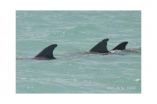(Press-News.org) This year's unusually long and rocky flu season would be nothing compared to the pandemic that could occur if bird flu became highly contagious among humans, which is why UCLA researchers and their colleagues are creating new ways to predict where an outbreak could emerge.
"Using surveillance of influenza cases in humans and birds, we've come up with a technique to predict sites where these viruses could mix and generate a future pandemic," said lead author Trevon Fuller, a UCLA postdoctoral research fellow at the Institute of the Environment and Sustainability's Center for Tropical Research.
The researchers' models revealed that coastal and central China and Egypt's Nile Delta are danger zones where bird flu could combine with human flu to create a virulent kind of super-flu. Governments can prioritize these zones — and use the researchers' models to identify other hotspots — for increased monitoring of flu in humans, livestock, poultry and wild birds. That could help detect a novel flu virus before it spreads worldwide, the researchers said.
The research paper, "Predicting Hotspots for Influenza Virus Reassortment," was published March 13 in the peer-reviewed public health journal Emerging Infectious Diseases.
Previous pandemics, such as the 1957 and 1968 influenzas that each killed more than a million people or the 2009 H1N1 swine flu outbreak that killed 280,000 worldwide, developed when viruses from humans and animals exchanged genes to create a new virus in a process called reassortment. Recent research using mice confirms that genes from bird flu and human flu can combine to create dangerous new flu strains. Swine, which are susceptible to both bird and human flu, could serve as a mixing vessel for reassortment between the two viruses.
"The mixing of genetic material between the seasonal human flu virus and bird flu can create novel virus strains that are more lethal than either of the original viruses," said senior author Thomas Smith, director of the Center for Tropical Research and a professor at UCLA's Institute of the Environment and Sustainability and the UCLA Department of Ecology and Evolutionary Biology.
"These findings predicting potential outbreak sites can help decision-makers prioritize the most important areas where people, poultry and livestock should be vaccinated and animals should be monitored for novel viruses, which could help predict and prevent the next pandemic," he said.
The researchers looked for locations where bird flu outbreaks, human flu outbreaks and swine populations overlapped to predict hotspots where reassortment is more likely, using a $1.3 million grant from the Fogarty International Center at the National Institutes of Health.
The research focused on two flu strains that studies in mice have shown can combine with lethal results: the seasonal H3N2 human flu, and the H5N1 strain of bird flu that has occasionally crossed over into humans. Currently, H5N1 has a 60 percent mortality rate in humans but is not known to spread between humans frequently.
While the World Health Organization has identified six countries as hosts to ongoing, widespread bird flu infections in poultry in 2011 — China, Egypt, India, Vietnam, Indonesia and Bangladesh — the UCLA researchers and their colleagues had limited data to work with. Not all flu outbreaks, whether bird or human, are tracked. The scientists had to identify indicators of flu outbreaks, such as dense poultry populations, or rain and temperatures that encourage flu transmission.
"For each type of flu, we identified variables that were predictive of the various virus strains," Fuller said. "We wanted a map of predictions continuously across the whole country, including locations where we didn't have data on flu outbreaks."
Although the researchers had bird flu data for parts of both China and Egypt, other countries, such as Indonesia, don't have full reporting systems in place. Even in China and Egypt, accurate reporting is hampered by farmers who may conceal flu outbreaks in order to sell their livestock.
"If we provide incentives for better reporting, we could more precisely predict future outbreaks," Fuller said.
###
Fuller and Smith also worked with Kevin Njabo, the Africa director at UCLA's Center for Tropical Research, and scientists from the Université Libre de Bruxelles, the Food and Agriculture Organization of the United Nations, the Centre de Cooperation International en Recherche Agronomique pour le Developpement, EcoHealth Alliance, the National Laboratory for Quality Control on Poultry Production in Egypt, and the University of Oklahoma.
The UCLA Institute of the Environment and Sustainability is an educational and research institute that unites disciplines: physical, life and social sciences; business and economics; public policy and urban planning; engineering and technology; and medicine and public health. The institute includes multiple cross-disciplinary research centers, and its environmental science undergraduate degree program is one of the fastest growing majors at UCLA. The institute also advises businesses and policymakers on sustainability and the environment and informs and encourages community discussion about critical environmental issues.
For more news, visit the UCLA Newsroom and follow us on Twitter.
Predicting hotspots for future flu outbreaks
2013-03-14
ELSE PRESS RELEASES FROM THIS DATE:
UF researcher describes new 5-million-year-old saber-toothed cat from Florida
2013-03-14
GAINESVILLE, Fla. --- A University of Florida researcher has described a new genus and species of extinct saber-toothed cat from Polk County, Fla., based on additional fossil acquisitions of the animal over the last 25 years.
The 5-million-year-old fossils belong to the same lineage as the famous Smilodon fatalis from the La Brea Tar Pits in Los Angeles, a large, carnivorous apex predator with elongated upper canine teeth. Previous research suggested the group of saber-toothed cats known as Smilodontini originated in the Old World and then migrated to North America, but ...
Autism Speaks trailblazer study -- Blocking cell distress signals can ease autism symptoms
2013-03-14
New York, N.Y. (March 14, 2013) – Autism Speaks, the world's leading autism science and advocacy organization, today announced a study supported by one of Autism Speaks' first Suzanne and Bob Wright Trailblazer Awards, presents a new theory that autism may result from chronic danger signaling by mitochondria, cell structures that supply our cells with energy. This study by Trailblazer researcher and mitochondrial medicine specialist Robert Naviaux, M.D., Ph.D., of the University of California, San Diego published in the journal PLOS-ONE supports a novel theory about the ...
Playing action videogames improves visual search
2013-03-14
Researchers at the University of Toronto have shown that playing shooting or driving videogames, even for a relatively short time, improves the ability to search for a target hidden among irrelevant distractions in complex scenes.
"Recent studies in different labs, including here at the University of Toronto, have shown that playing first-person shooter videogames can enhance other aspects of visual attention," says psychology professor Ian Spence. "But no one has previously demonstrated that visual search is also improved."
Searching efficiently and accurately is ...
AAN: Doctors caution against prescribing attention-boosting drugs for healthy kids
2013-03-14
MINNEAPOLIS – The American Academy of Neurology (AAN), the world's largest professional association of neurologists, is releasing a position paper on how the practice of prescribing drugs to boost cognitive function, or memory and thinking abilities, in healthy children and teens is misguided. The statement is published in the March 13, 2013, online issue of Neurology, the medical journal of the American Academy of Neurology.
This growing trend, in which teens use "study drugs" before tests and parents request ADHD drugs for kids who don't meet the criteria for the disorder, ...
Whale's streaming baleen tangles to trap food
2013-03-14
Diving and plunging through the waves to feed, some whales throw their jaws wide and engulf colossal mouthfuls of fish-laden water while other species simply coast along with their mouths agape (ram or skim feeding), yet both feeding styles rely on a remarkable substance in the whales' mouths to filter nutrition from the ocean: baleen. Alexander Werth from Hampden-Sydney College, USA, explains that no one knew how the hairy substance actually traps morsels of food. 'The standard view was that baleen is just a static material and people had never thought of it moving or ...
Goats' milk with antimicrobial lysozyme speeds recovery from diarrhea
2013-03-14
Milk from goats that were genetically modified to produce higher levels of a human antimicrobial protein has proved effective in treating diarrhea in young pigs, demonstrating the potential for food products from transgenic animals to one day also benefit human health, report researchers at the University of California, Davis.
The study is the first on record to show that goats' milk carrying elevated levels of the antimicrobial lysozyme, a protein found in human breast milk, can successfully treat diarrhea caused by bacterial infection in the gastrointestinal tract.
The ...
Overheard phone calls more memorable, rated more distracting than other background talking
2013-03-14
A one-sided cellphone conversation in the background is likely to be much more distracting than overhearing a conversation between two people, according to research published March 13 in the open access journal PLOS ONE by Veronica Galván and colleagues from the University of San Diego.
The authors studied the effects of overhearing either one side of a cell phone call or a chat between two people on the attention and memory of people who overheard these conversations. Participants in the study were asked to complete a task involving anagrams. As they performed the task, ...
Bottlenose dolphin leaders more likely to lead relatives than unrelated individuals
2013-03-14
Traveling into uncharted territory in search of food can be a dangerous undertaking, but some bottlenose dolphins may benefit by moving through their habitat with relatives who may be more experienced or knowledgeable. It turns out that leaders in bottlenose dolphin groups in the Florida Keys are more likely to be related to the dolphins that follow them, according to research published March 13 by Jennifer Lewis and colleagues from Florida International University.
In complex habitats like the shallow waters of the Florida Keys, individuals who follow may benefit from ...
Study: Catheter-based varicose vein treatments more cost-effective
2013-03-14
DETROIT – Treating varicose veins with vein-stripping surgery is associated with higher costs than closing the veins with heat, according to a study at Henry Ford Hospital in Detroit.
"Cost-effectiveness is an important factor to consider when comparing different treatments for varicose vein disease," says Judith C. Lin, M.D., vascular surgeon and lead author of the study. "And these two types of treatment have similar effectiveness."
The study will be presented March 13 at the 41st Annual Symposium of the Society for Clinical Vascular Surgery in Miami.
The current ...
Implementing HPV vaccinations at a young age is significant for vaccine effectiveness
2013-03-14
Initial vaccinations for human papillomavirus (HPV) at a young age is important for maximizing quadrivalent HPV vaccine effectiveness according to a Swedish study published March 13 in the Journal of the National Cancer Institute.
HPV vaccination programs have been launched around the world in hopes of preventing cervical cancer and other HPV-related cancers. While incidence of genital warts is the earliest possible disease outcome to measure the efficacy of the HPV vaccine, the results of such efficacy trials may not be fully generalizable to real-life HPV vaccination ...

